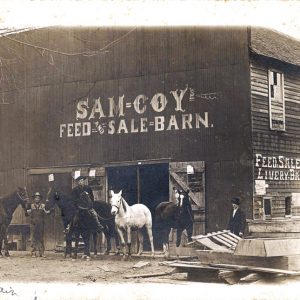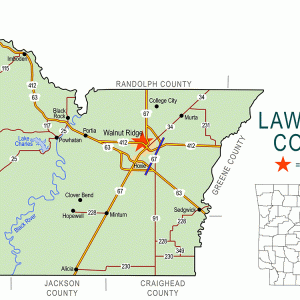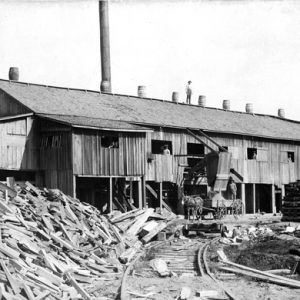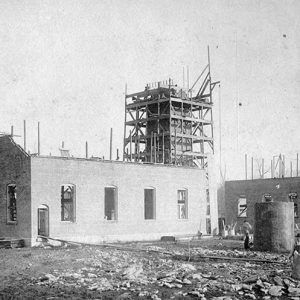calsfoundation@cals.org
Portia (Lawrence County)
| Latitude and Longitude: | 36º05’11″N 091º04’02″W |
| Elevation: | 259 feet |
| Area: | 1.29 square miles (2020 Census) |
| Population: | 424 (2020 Census) |
| Incorporation Date: | May 19, 1886 |
Historical Population as per the U.S. Census:
|
1810 |
1820 |
1830 |
1840 |
1850 |
1860 |
1870 |
1880 |
1890 |
1900 |
|
– |
– |
– |
– |
– |
– |
– |
– |
571 |
400 |
|
1910 |
1920 |
1930 |
1940 |
1950 |
1960 |
1970 |
1980 |
1990 |
2000 |
|
367 |
519 |
416 |
393 |
349 |
333 |
381 |
480 |
521 |
483 |
|
2010 |
2020 |
|
|
|
|
|
|
|
|
|
437 |
424 |
|
|
|
|
|
|
|
The area that became the town of Portia in the late nineteenth century was home to some of Arkansas’s earliest settlers. Incorporated in 1886, the town, located on U.S. Highway 63, was once an important business center and timber-producing area. In the twenty-first century, however, its business district is declining.
Native Americans were the first to settle the area around Portia, as evidenced by the many artifacts found along the banks of the nearby Spring and Black rivers. The first white settlers to the area probably arrived around 1800 as a result of two Spanish land grants, one of which included the land where the present town is located. In 1816, the General Land Office in Washington DC confirmed the grant under the ownership of Joseph Guignolet. Though the area was said to have been continuously occupied since 1802, it is doubtful that Guignolet lived there for very long. The earliest settlers, such as John Arendale, began to establish homesteads north of the present town along the Spring River. Sometime during the Civil War, John Coffman homesteaded the land that later became the town.
No real town began to develop until the coming of the Fort Scott–Kansas City Railroad in 1882. The town quickly grew on both sides of the track. Portia was incorporated on May 19, 1886. Due to its convenient location to both river travel and the railroad, the town was considered for relocation of the seat of government for Lawrence County. After much debate, the seat remained in Powhatan. Many believed that the move had been vetoed because of reporting by local populist newspaper editors W. S. and S. W. Morgan and their criticism of the Democratic Party. The paper, The Portia Free Press, was published from 1886 to 1888.
By 1890, Portia was home to 571 citizens, and Methodist and Baptist congregations were established. In 1889, Portia was described as a “railroad village” with eight businesses, including three general stores and two sawmills. Most of the area’s residents were farmers who produced cotton, corn, and hay. Still, many found work in the growing timber industry. By 1890, the Portia Lumber Company was established, employing many residents. However, the town’s population began to decrease with the decline of the timber industry by the turn of the century.
By 1903, the town had eleven businesses, including two cotton gins. It was also home to a section house and depot where two passenger and two freight trains passed through daily. One such freight train delivered the town’s first automobile to Chloral Anderson. The Bank of Portia was organized in 1904, with Eugene J. Mason as president. It was liquidated in 1930 and sold to the First National Bank of Black Rock. In 1973, the Citizens Bank of Lawrence County opened. No banks operate in the town as of 2010.
In 1906, a devastating fire swept through the town, having been ignited by a butcher shop’s exploding coal oil lamp. Winds quickly spread the fire until all of the businesses on the south side of the tracks were destroyed. A number of homes were also burned, requiring some citizens to live temporarily in tents. The fire resulted in a town ordinance requiring new buildings to be constructed of brick or some other fire-retardant material. Many did not rebuild.
The first school, built sometime before 1903, was a two-room frame structure located on ten acres just south of the town. A two-story brick structure, which still stands, was constructed in 1914 near the center of the town; it is listed on the National Register of Historic Places. In 1936, during the Great Depression, a gym was built by the Works Progress Administration (WPA); it was destroyed by fire in 1972. In 1938, a home economics building was built. In 1948, grades 7–12 were consolidated with Black Rock (Lawrence County), and, within a few years, the remaining grades were also sent to Black Rock.
In 1905, the town leaders initiated a festival held the first week in July called the Portia Picnic. People from the surrounding countryside came into town to see the sights and to hear speeches delivered by politicians. Some picnics were said to have up to 10,000 visitors. The festival is still held each summer.
Many expected the town to grow with the construction of a new bridge across the Black River and the paving of U.S. Highway 63. That growth never came. As of 2010, Portia is a town of 437 citizens, with very few businesses, surrounded by farm fields. Those who do not cultivate the main crops of cotton, soybeans, and watermelons make a living commuting to jobs at nearby Walnut Ridge (Lawrence County) or as far away as Jonesboro (Craighead County).
The town is home to three properties on the National Register of Historic Places. The Portia School was listed in 1978. In 1990, the Home Economics/FFA Building was added, and the Dr. F. W. Buercklin House in 1998.
For additional information:
Biographical and Historical Memoirs of Northeast Arkansas. Chicago: Goodspeed Publishers, 1889.
Covey, Reta Goff. “A History of Portia.” Lawrence County Historical Quarterly 15 (Spring 1992): 8–13.
Lawrence County, Arkansas: 1815–2001. Paducah, KY: Turner Publishing Company, 2001.
McLeod, Walter E. Centennial Memorial History of Lawrence County. Russellville, AR: Russellville Printing Company, 1936.
Michael Polston
CALS Encyclopedia of Arkansas
 Coy Feed and Sale Barn
Coy Feed and Sale Barn  Lawrence County Map
Lawrence County Map  Portia Bay
Portia Bay  Portia Depot
Portia Depot  Portia Lumber Company
Portia Lumber Company  Prairie Oil and Gas
Prairie Oil and Gas 



Comments
No comments on this entry yet.